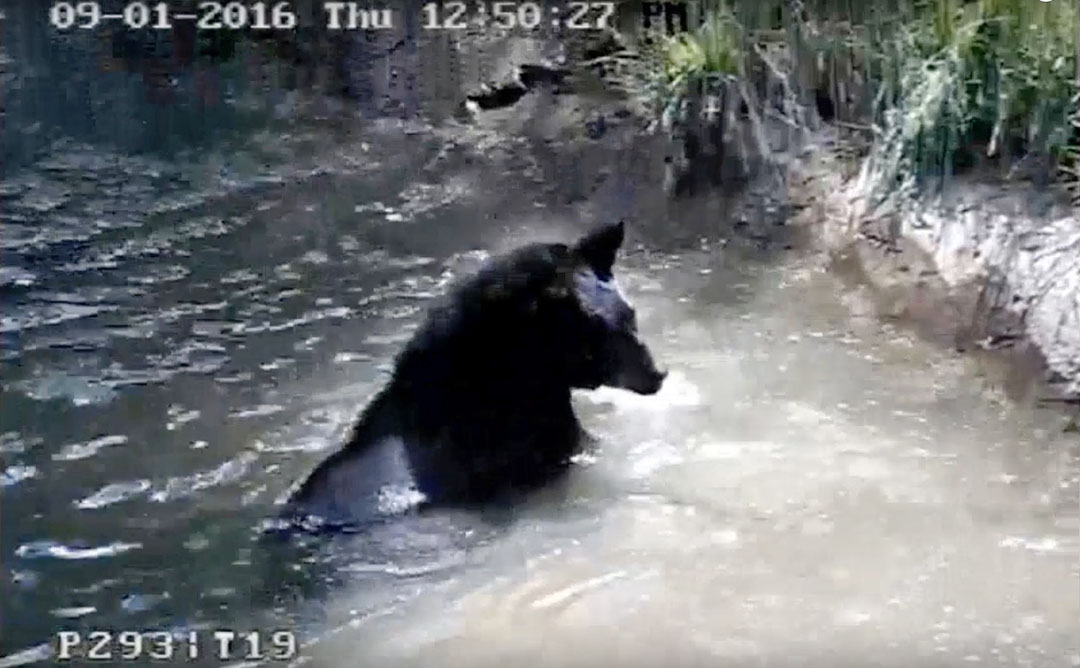Tasha’s First Swim, First Outing with Lucky - UPDATE September 1, 2016
On this first day of bear-hunting, I’m glad I can be writing about Tasha and Lucky. We haven’t heard any shots.
At the Bear Center, it was Tasha’s first outing with Lucky.  Tasha in the pondThe others were penned up for the occasion. Lucky gave chase but no problem. She took her first swim and seemed to enjoy it although she stayed in for only 3-4 minutes. The suspense is over. She was out with Lucky without a problem. We had interpreted all of Lucky’s ferocious-looking displays toward Tasha as expressions of uncertainty, not anger or outright ferocity. But we had been cautious, just in case. Today we were relieved and even more confident about the meaning of the lunging, ground-slapping, and explosive blowing displays we saw. Tasha is making progress. Yesterday she ventured onto the scale and weighed in at 182. Today, Lucky and the pond.
Tasha in the pondThe others were penned up for the occasion. Lucky gave chase but no problem. She took her first swim and seemed to enjoy it although she stayed in for only 3-4 minutes. The suspense is over. She was out with Lucky without a problem. We had interpreted all of Lucky’s ferocious-looking displays toward Tasha as expressions of uncertainty, not anger or outright ferocity. But we had been cautious, just in case. Today we were relieved and even more confident about the meaning of the lunging, ground-slapping, and explosive blowing displays we saw. Tasha is making progress. Yesterday she ventured onto the scale and weighed in at 182. Today, Lucky and the pond.
Here is a video of Tasha on the scale from yesterday: https://www.youtube.com/watch?v=8uK-HVhUtw0 and a video of her big swim today: https://www.youtube.com/watch?v=o1rpThqkPYQ.
Last night, Lily was seen looking lethargic as if she is almost ready to enter a den. She is pregnant and expected to den early. When she was pregnant and radio-collared four years ago, she entered the brush pile den on September 10, 2012. That winter was the last year we were able to watch her. To quote a couple sentences from the Den Cam manuscript, she “gave birth on 12 January 2013 and left the den on 23 April 2013 after being delayed by a week of unusually cold temperatures (-23 to +9 degrees C) and a blizzard that added 56 cm of snow. The family left when a crust formed on the 62 cm of remaining snow.”
We’re wondering, of course, when Tasha will enter a den. Being from Kentucky, we don’t know what her genes will tell her to do. She is already big for her age after being fed all last winter by the man who raised her. I suspect she is genetically programmed to eat late into fall and den up in late November or early December. I suspect she is also programmed to be flexible about hibernating. Bears that live where there is a good possibility of winter food such as beechnuts, hickory nuts, and acorns often stay up all winter if food is available. She will tell us what to do.
It’s only 4 PM. We hope the rest of this day continues as well as it has so far.
Thank you for all you do.
Lynn Rogers, Biologist, Wildlife Research Institute and North American Bear Center
